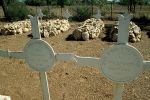Biography – Trooper James Edwin Walker
Regimental No 75 'A' Squadron, NSW Bushmen's Contingent
James Edwin Walker, a drover, was born in Yorkshire on 7 March 1868 and at the time of his enlistment, as a trooper in the NSW Bushmen's Contingent, gave his next of kin as a cousin living in Nagambie, Victoria.1
The formation of this contingent generated considerable interest before it embarked for South Africa. A mid-week race programme was held at Randwick Racecourse, in Sydney, in the contingent's honour. Of this event Boer war historian, Robert Wallace, writes:
In a six-event programme, two races were confined to riders of the Bushmen's contingent. The horses were contingent horses. The riders rode in full uniform with leggings and forage cap. No colours were worn, only a number on the saddle slip. Both races were won by a gelding named, Uproar. With Trooper J E Walker in the saddle he defeated the favourite in the 'Our Boys Plate'.2
James Walker also rode at this meeting his mount winning by two lengths from Wongarah, ridden by Lieutenant Arthur Battye of the 'Forbes Fifty'. The prize for the event was a trophy valued at 40 sovereigns.3
Trooper Walker sailed with the contingent on 28 February 1900, arrived in Capetown on 2 April and then proceeded via Marandelles to Bulawayo, Rhodesia (Zimbabwe). His Squadron served under General Plummer in the engagements at Mafeking and Rustenburg. The major engagement for the squadron, with some assistance from about 50 men of other details, was the defence of Eland's River. Refusing to surrender on any terms, they held out against De la Rey with 1,000 men and guns for 13 days. They were eventually relieved by Lord Kitchener's force on 15th August and Lord Methuen's column which arrived from the north on 18 August, 1900.4
On 6 August 1900 James Walker was wounded and died at Elands River. The Rev James Green, a Methodist minister with the Bushmen wrote:
Every day we had casualties until the number was over 75, including 18 deaths, four of whom were New South Wales men – Wardell, Duff, Walker and Mitchell.5
Heavy enemy fire prevented any burial services being held until 17 August, when the Rev Green read the burial service over the graves of Troopers James Walker, James Duff, John Waddell and Sergeant Major James Mitchell. A single piece of slate served as a headstone for the four Bushmen. He continued –
We held a great military funeral service. The troops were drawn up in a square, around the graves, and after the service had been read, the firing party fired volleys, during which the buglers played different bugle-calls. The men collected white stones, and placed them round the graves. Headstones of slate, got from the neighbouring hills, were put up, and the names of the dead carved thereon, and barbed wire fence was constructed around the little cemetery.6
The original headstone of slate that stood over the graves of Walker and his three fellow Bushmen is now on display in the Australians in South Africa gallery at the Australian War Memorial, Canberra. A number of years ago, four individual metal crosses replaced this headstone, which was then brought to Australia.
1 Nominal Roll, NSW Bushmens Contingent, National Archives of Australia, microfilm B5204.
2 The Australians at the Boer War, Robert L Wallace, Canberra, 1976, p234.
3 Town and Country Journal, 24 February 1900.
4 Official Records of the Australian Military Contingents to the War in South Africa, P L Murray, Melbourne 1911.
5 The Story of the Australian Bushmen (being notes of a Chaplain), James Green, Sydney, 1903.
6 ibid.



